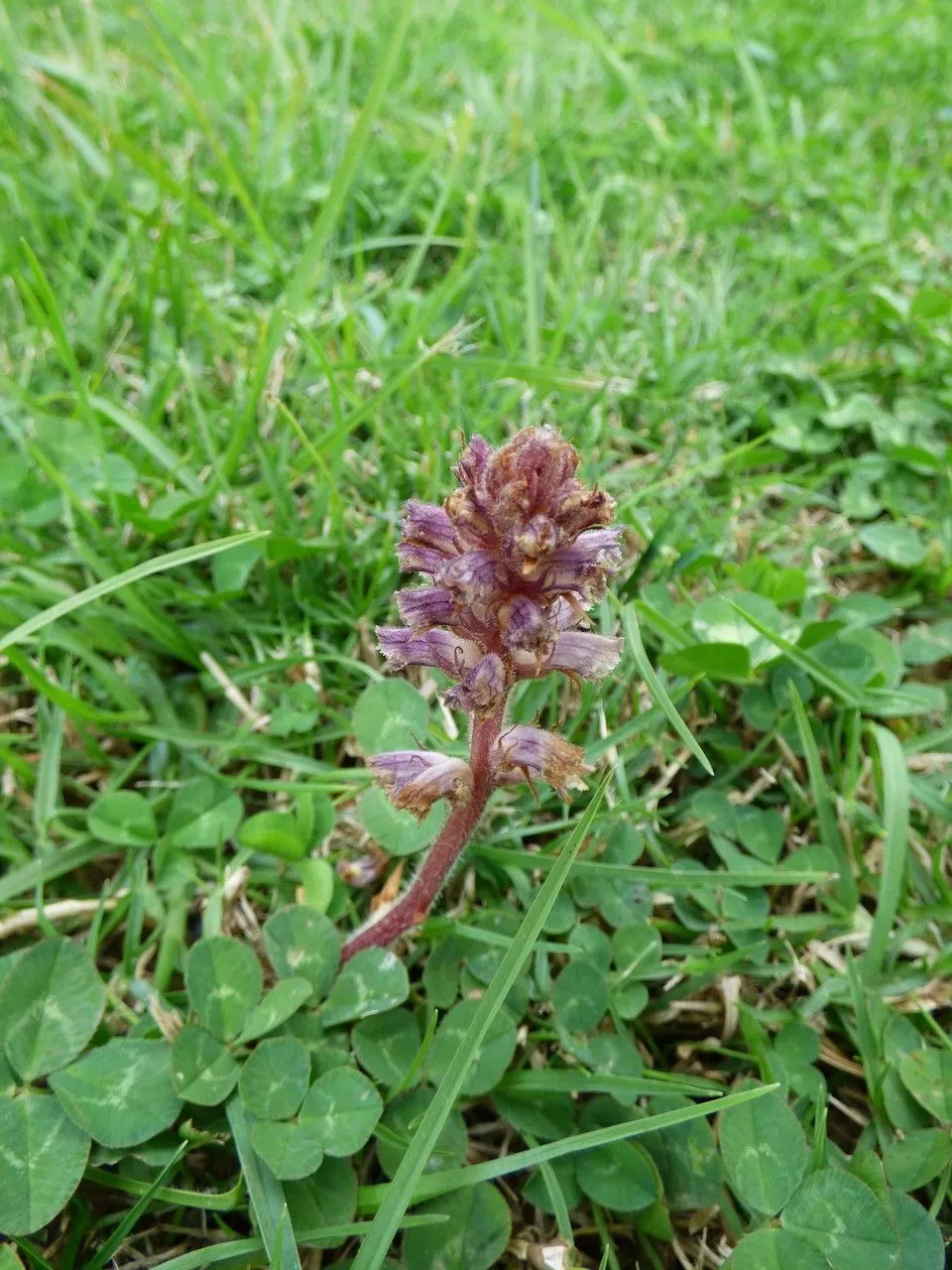
Author: Sm.
Bibliography: Engl. Bot. 6: t. 422 (1797)
Year: 1797
Status: accepted
Rank: species
Genus: Orobanche
Vegetable: False
Observations: Europe to N. Iraq, Macaronesia to Arabian Pen. and S. Trop. Africa
The Clover broomrape, known scientifically as Orobanche minor, is a fascinating and distinctive plant belonging to the Orobanchaceae family. First documented by the noted botanist, Samuel Frederick Gray, in 1797, this species has captivated botanists and plant enthusiasts for centuries.
Clover broomrape is an intriguing parasitic plant that lacks chlorophyll, which means it does not perform photosynthesis. Instead, it derives its nutrients by parasitizing the roots of various host plants, particularly members of the legume family, such as clover. This dependency on host plants adds a unique aspect to its ecological role and lifecycle.
The distribution of Orobanche minor is quite extensive. Native to Europe, its range extends as far east as northern Iraq. Additionally, it is found across regions from Macaronesia to the Arabian Peninsula and sub-Saharan tropical Africa. This wide distribution indicates the plant’s ability to adapt to diverse climates and environments, from temperate regions to more arid zones.
Clover broomrape is renowned for its unusual appearance, which can make it both a botanical curiosity and a concern in agricultural settings. The plant typically exhibits a striking inflorescence, emerging above ground as a dense spike of tubular flowers. These flowers vary in color, often presenting shades of purple, yellow, or white, depending on the specific variety and growing conditions.
Despite its parasitic nature, Orobanche minor performs vital ecological functions. It plays a role in the complex web of interactions within its ecosystem, influencing plant community dynamics and soil health. However, its presence can also be problematic for agriculture, as heavy infestations on crops can lead to significant yield losses.
The study of Clover broomrape continues to provide valuable insights into parasitic plant biology, plant-host interactions, and ecological adaptation. Its long-standing presence in botanical literature and ongoing research underscores its significance in both natural and cultivated landscapes.
Eng: common broomrape, hellroot, clover broomrape, lesser broomrape, small broomrape
Deu: klee-wuerger, kleeteufel, kleewürger, kleine sommerwurz
Dan: kløver-gyvelkvæler
Afr: bremraap, klawerbesemraap
Nld: klavervreter
Swe: klöversnyltrot
Fra: orobanche du trèfle, petit orobanche
Spa: rabo de lobo
Ces: záraza menšia, záraza menší
Nob: kløversnylterot
Nno: kløversnylterot
Cym: gorfanadl, gorfanc lleiaf, gorfanhadlen, orfanc lleiaf cyffredin, tag y manal, tag yr eithin
En: Clover broomrape, Common broomrape, Lesser broomrape, Small broomrape, Hellroot, Small broorape, Lesser broom-rape
Af: Bremraap, Klawerbesemraap
Ar: دوانين، دواويل, زب الديب (زَب الدِيب), هلوك، زب الأرض, هالوك صغير
Cs: Záraza menší, Záraza menšia
Da: Kløver-gyvelkvæler
Nl: Klavervreter
Eo: Eta orobanko
Fi: Apilannäive
Fr: Petit orobanche, Orobanche du trèfle, Petite Orobanche, Orobanche à petites fleurs
De: Kleeteufel, Kleewürger, Kleine Sommerwurz, Klee-Wuerger, Klee-Würger
Ga: Múchóg bheag
It: Succiamele minore
Nb: Kløversnylterot
Nn: Kløversnylterot
Pl: Zaraza drobnokwiatowa
Pt: Erva-toira-menor, Erva-toira-pequena, Orobanca
Pt-br: Erva-toura-menor
Sr: Мала водњача
Sk: Záraza menšia
Es: Rabo de lobo
Sv: Klöversnyltrot
Uk: Вовчок малий
Cy: Gorfanhadlen gorfanadl, Gorfanadl, Gorfanc Lleiaf, Gorfanhadlen, Orfanc Lleiaf Cyffredin, Tag y Manal, Tag yr Eithin
Taken May 13, 2021 by franchi Gianni (cc-by-sa)
Taken Jul 24, 2017 by Hugo SANTACREU (cc-by-sa)
Taken Jul 24, 2017 by Hugo SANTACREU (cc-by-sa)
Taken Jul 24, 2017 by Hugo SANTACREU (cc-by-sa)
Taken Jun 12, 2018 by Irène MARIETTE (cc-by-sa)
Taken May 27, 2021 by Pierre LEON (cc-by-sa)
Taken Jul 9, 2021 by Pierre LEON (cc-by-sa)
Taken May 27, 2021 by Pierre LEON (cc-by-sa)
Taken Jun 1, 2020 by Denis Bastianelli (cc-by-sa)
Taken Jul 24, 2017 by Hugo SANTACREU (cc-by-sa)
Taken May 11, 2022 by Serge Klein (cc-by-sa)
Taken Apr 30, 1849 by Tela Botanica − Herbier PONTARLIER-MARICHAL (cc-by-sa)
Taken Jun 17, 1903 by Tela Botanica − Anne-Marie GRIMAUD (cc-by-sa)
Taken May 5, 2021 by Llandrich anna (cc-by-sa)
Taken May 25, 2022 by John Sycorax (cc-by-sa)
Taken Apr 30, 2016 by Tela Botanica − Florent BECK (cc-by-sa)
Taken Apr 30, 2016 by Tela Botanica − Florent BECK (cc-by-sa)
Taken Apr 30, 2016 by Tela Botanica − Florent BECK (cc-by-sa)
Taken May 23, 2022 by Hmdy Akn (cc-by-sa)
Taken May 5, 2021 by Llandrich anna (cc-by-sa)
© copyright of the Board of Trustees of the Royal Botanic Gardens, Kew.
© copyright of the Board of Trustees of the Royal Botanic Gardens, Kew.
© copyright of the Board of Trustees of the Royal Botanic Gardens, Kew.
Taken May 11, 2019 by GUILLAUME Tourenne (cc-by-sa)
Taken May 6, 2020 by Carine Chifoumi (cc-by-sa)
Taken May 23, 2022 by Hmdy Akn (cc-by-sa)
Taken Mar 27, 2020 by Verdasca Donzilia (cc-by-sa)
Taken Apr 26, 2017 by César Gonzalez (cc-by-sa)
Taken Feb 18, 2022 by nounou chouche (cc-by-sa)
Taken Jul 18, 2022 by Guy Carqueville (cc-by-sa)
Taken Nov 27, 2019 by Roselyne Thomas (cc-by-sa)
Taken May 22, 2022 by Jozef Šuster (cc-by-sa)
Taken May 23, 2022 by Hmdy Akn (cc-by-sa)
Growth habit: Forb/herb
Ph maximum: 7.0
Ph minimum: 6.5
Light: 7
Atmospheric humidity: 4
Soil nutriments: 4
Family: Myrtaceae Author: (F.Muell.) K.D.Hill & L.A.S.Johnson Bibliography: Telopea 6: 402 (1995) Year: 1995 Status:…
Family: Rubiaceae Author: Pierre ex A.Froehner Bibliography: Notizbl. Bot. Gart. Berlin-Dahlem 1: 237 (1897) Year:…
Family: Sapindaceae Author: Koidz. Bibliography: J. Coll. Sci. Imp. Univ. Tokyo 32(1): 38 (1911) Year:…
Family: Asteraceae Author: A.Gray Bibliography: Pacif. Railr. Rep.: 107 (1857) Year: 1857 Status: accepted Rank:…
Family: Fabaceae Author: Medik. Bibliography: Vorles. Churpfälz. Phys.-Ökon. Ges. 2: 398 (1787) Year: 1787 Status:…
Family: Aspleniaceae Author: (Cav.) Alston Bibliography: Bull. Misc. Inform. Kew 1932: 309 (1932) Year: 1932…